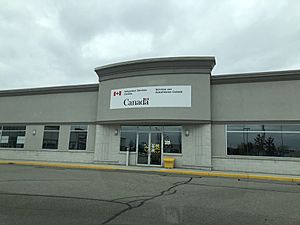Indigenous Services Canada facts for kids
| Services aux Autochtones Canada | |
| Department overview | |
|---|---|
| Formed | 2019 |
| Preceding Department | |
| Jurisdiction | Canada |
| Minister responsible |
|
| Department executive |
|
Indigenous Services Canada (ISC; French: Services aux Autochtones Canada) is a department within the Government of Canada. Its main goal is to work with Indigenous peoples in Canada (including First Nations, Inuit, and Métis). ISC helps to improve access to important services for these communities.
The department was created in 2019. It took over some of the responsibilities of an older department. ISC reports to the Parliament through the Minister of Indigenous Services. The current minister is Patty Hajdu. The daily work of the department is managed by a Deputy Minister, who is a public servant. ISC's main office is in Gatineau, Quebec.
Contents
Why the Department Changed
In 2017, the Canadian government decided to change how it worked with Indigenous peoples. The old department, called Indian Affairs and Northern Development, was split into two new ones. Indigenous Services Canada was one of these new departments. This change officially happened in July 2019.
The government wanted to move away from older, more controlling ways of working with Indigenous communities. The new departments aim to improve services and help Indigenous groups achieve self-government. This change was suggested by a special report in 1996.
Improving Community Services
Indigenous Services Canada helps First Nations communities with their basic needs. This includes building and keeping up important things like homes, schools, water systems, and roads. These are all part of a community's infrastructure.
For many years, there has been a need for more investment in these areas. Reports have shown that some communities lack good access to services like garbage collection or safe drinking water. ISC works to fix these issues.
First Nations Infrastructure Fund
The First Nations Infrastructure Fund (FNIF) was started in 2007. Its purpose was to make life better for First Nation communities. It helped fund projects for things like:
- Planning and skill development
- Managing solid waste
- Building and repairing roads and bridges
- Energy systems
- Internet access (connectivity)
Communities could apply for up to $10 million over five years from this fund. This helped many communities start important projects.
Water and Wastewater Systems
A big part of improving services is making sure communities have safe water. The First Nations Water and Wastewater Action Plan (FNWWAP) is a long-term effort to improve water systems.
Challenges with Water Systems
For a long time, there have been concerns about water quality in some First Nation communities. In 2005, a government report noted that there were no specific laws to make sure water on reserves met Canadian drinking water standards. This was different from other parts of Canada.
National Water System Assessment
In 1991, less than 80% of homes on reserves had basic water and sewer services. By 2001, this number had improved, with about 98% having water and 94% having sewer services.
A study in 2003 looked at water systems in 740 communities. It found that about 29% of these systems had a high risk of affecting water quality. Only 25% were considered low risk. The study estimated that it would cost a lot of money to fix these problems.
Another big study was done between 2009 and 2011. Engineers checked over 4,000 water and wastewater systems in 571 First Nation communities. This study found that 39% of water systems were at high risk of being unsafe. This affected about a quarter of the people living on reserves.
The study suggested that Canada would need over $1 billion to fix these problems. It also said billions more would be needed over 10 years to keep up with growing demand. These assessments show that many communities still face challenges with getting safe and reliable water.


